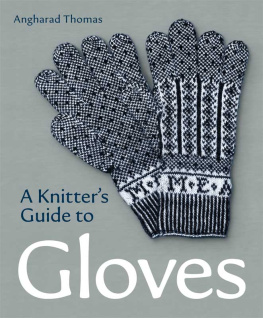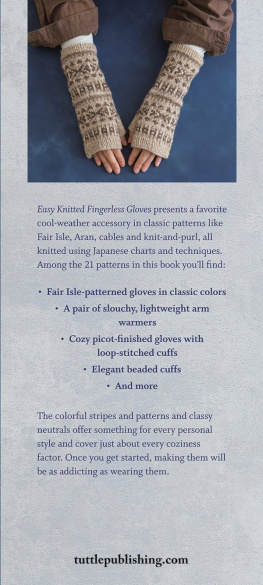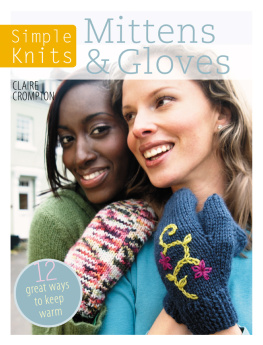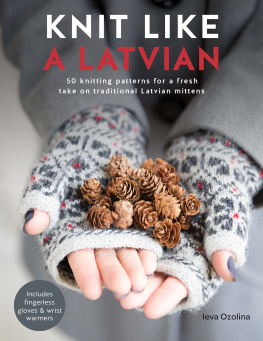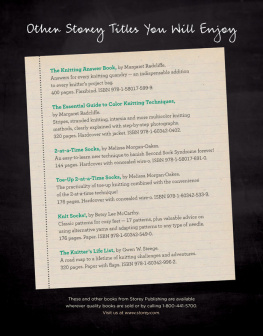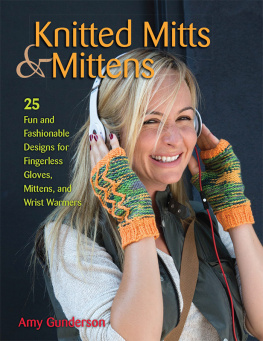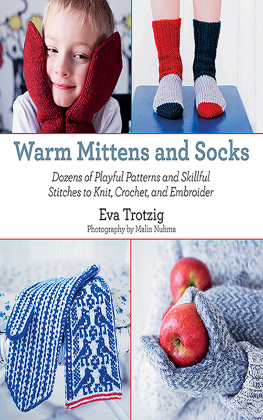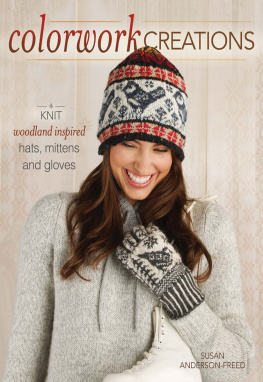
For my parents
Published in 2008 by Stewart, Tabori & Chang
An imprint of Harry N. Abrams, Inc.
Text copyright 2008 by Robin Melanson
Photographs copyright 2008 by Tyllie Barbosa
All rights reserved. No portion of this book may be reproduced, stored in a retrieval system, or transmitted in any form or by any means, mechanical, electronic, photocopying, recording, or otherwise, without written permission from the publisher.
Library of Congress Cataloging-in-Publication Data:
Melanson, Robin.
Knitting new mittens and gloves : warm and adorn your
hands in 28 innovative ways / Robin Melanson.
p. cm.
Includes bibliographical references.
ISBN 978-1-4532-6835-3
1. Knitting--Patterns. 2. Mittens. 3. Gloves. I. Title.
TT825.M413 2008
746.43'2041--dc22
2007019273
Editors: Melanie Falick and Liana Allday
Designer: Sarah Von Dreele
Production Manager: Jacquie Poirier
The text of this book was composed in Futura
and Janson.
10 9 8 7 6 5 4 3 2 1

115 West 18th Street
New York, NY 10011
www.hnabooks.com
K n i t t i n g N ew
Mittens & Gloves
WARM AND ADORN YOUR HANDS IN 28 INNOVATIVE WAYS
ROBIN MELANSON
PHOTOGRAPHS BY TYLLIE BARBOSA
PHOTO-STYLING BY KELLY McKAIG
STC Craft/A Melanie Falick Book | Stewart, Tabori & Chang | New York
Table of Contents

Introduction
When the possibility of writing a book of new mitten and glove patterns was presented to me, I was immediately intrigued as I consider myself a mitten and glove aficionado of sorts. I grew up in Cape Breton, on Canadas Atlantic coast, where winters tend to be harsh and mittens and gloves are essential in everyones wardrobes. I recognized right away that this would be a wonderful opportunity for me to explore new avenues of design and to share my enthusiasm for these humble items.
Like many knitters, I am especially drawn to mittens and gloves because they are useful, generally quick to make, small enough to carry around while being worked on and to work on even in warm weather without discomfort, and dont require a lot of yarn. They are also a great project on which to experimentto try out new techniques or yarns that can be applied later to larger endeavors. Since I prefer not to knit the same project over and over again, Im always stimulated by a fresh challenge and by the opportunity to view something familiar with a new perspective. When I accepted the opportunity to work on this book, I set the following goal: to redefine how mittens and gloves are made and worn by experimenting with and mixing and matching traditional and nontraditional techniques and influences. On the pages that follow are the results. For example, on , I challenged the utilitarian boundary of the glove: This design is intended as a purely decorative accessory rather than a winter essential.
As you may have already guessed by scanning the project list on or an influence in my choice of colors, buttons, or project names. I have also spent a lot of time reading medieval European literature, Norse and Icelandic sagas, and Early Irish heroic cycles. Often I am inspired by a name, a character, or an interesting description, or even just by thinking about a particular era in history. I follow fashion with interest but not slavishly; I pay the most attention to avant-garde runway shows with models sprouting antlers or donning designs incorporating futuristic shapes with intricate hand-finished details. While these interests do not always translate directly into my knitting, they do inform my outlook on design and my general aesthetic.
As I began the adventure of designing the projects for this book, I recalled reading in the science-fiction novel The Terminal Experiment by Robert. J. Sawyer that the funniest jokes are created when an unexpected association causes the brain to generate a new pathway, which translates as humor. I think the same is true when creating new knitwear designs: An inventive combination of familiar styles and materials produces a sense of freshness and originality that may not have been evident within any of the components individually. I think you will find that the designs that follow are fresh but not faddish, unusual but not outlandish. They are grounded in history and technique, but each has some new element or combination wrought into it. I hope that working on these mittens and gloves will inspire in you an ever-increasing fondness for and fascination with them. That is certainly how designing and knitting them has rewarded me.

Accomplice
These easy-to-make hand-warmers can be worn with or without gloves underneath. Worked in a luscious silk/mohair blend yarn, they keep the wrist and forearm warm and sweep gracefully over the top of the hand. The barred pattern is created by passing yarnovers over the subsequent stitches, making a channel of yarn floats. The hand edge is finished with a few rows of a slipped stitch pattern, and the thumb hole is created by making a few chain stitches from the last stitch of the bind-off row and attaching it to a spot on the opposite side.
Sizes
One size (to fit average woman)
Finished Measurements
Approximately 7" wrist circumference;
approximately 9" hand circumference
Yarn
Fleece Artist Kid Silk 3-ply (70% kid mohair / 30% silk; 220 yards [201 meters] / 100 grams): 1 hank vintage
Needles
One set of four double-pointed needles (dpn) size US 7 (4.5 mm)
Change needle size if necessary to obtain correct gauge.
Notions
Crochet hook size US 7 (4.5 mm); stitch marker
Gauge
18 sts and 24 rnds = 4" (10 cm) in Barred Pattern
Stitch Patterns
Barred Pattern
(multiple of 5 sts; 2-rnd repeat)
Rnd 1: Knit.
Rnd 2: *Yo, k2, pass yo over last 2 sts worked, k3; repeat from * around.
Repeat Rnds 1 and 2 for Barred Pattern.
Linen Stitch
(multiple of 2 sts; 2-rnd repeat)
Rnd 1: *K1, slip 1 purlwise wyif; repeat from * around.
Rnd 2: *Slip 1 purlwise wyif, k1; repeat from * around.
Repeat Rnds 1 and 2 for Linen Stitch.
Hand Warmers (both alike)
With Long-Tail CO , CO 35 sts, divide among 3 needles [12-12-11]. Join for working in the rnd, being careful not to twist sts; place marker (pm) for beginning of rnd. Begin Barred Pattern. Work even for 31 rows (work should measure approximately 5" from the beginning).
Increase Rnd: *Yo, k2, pass yo over last 2 sts worked, k2, M1L, k1; repeat from * around42 sts.
Next Rnd: Knit.
Next Rnd: *Yo, k2, pass yo over last 2 sts worked, k4; repeat from * around.
Repeat last 2 rnds 6 times. Knit 1 rnd.
Next Rnd: Change to Linen st. Work even for 5 rnds.
BO 41 sts1 st remains. Cut yarn, leaving a long tail. Insert crochet hook into last st and ch 6. Fasten off. Sew end of chain approximately 12 sts away from beginning of chain along BO edge, creating a thumb hole.



